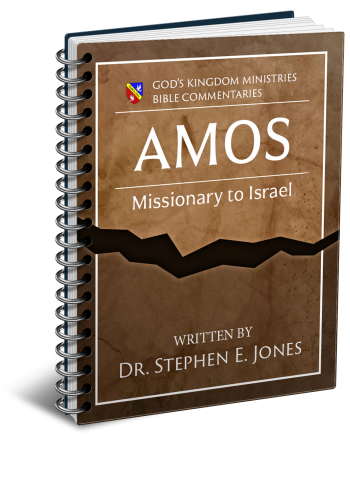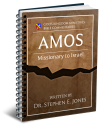Latest Posts
View the latest posts in an easy-to-read list format, with filtering options.

Amos was a missionary from Judah to Israel, giving them a final warning to repent before divine judgment was to destroy the nation. They refused, and two years later the nation was struck by a massive earthquake that destroyed their defenses and allowed the Assyrians to conquer them easily.
Category - Bible Commentaries

Amos was from Tekoah, a town about six miles south of Bethlehem and twelve miles south of Jerusalem. It was a pasture land, and Amos was a shepherd and herdsman. He was not a professional prophet, yet he was given visions from God and commissioned to preach to the spiritually corrupt House of Israel.
His prophecies, then, applied specifically to Israel, not to Judah, although the underlying principles set forth in his writings apply universally to all nations, including Judah. It is a common mistake among commentators to apply Amos’ prophecies to the Jews or to the Jewish state (misnamed Israel). The Jews trace their origins to back to Judah, not to Israel. The Jewish historian, Josephus, tells us,
“Wherefore there are but two tribes in Asia and Europe subject to the Romans; while the ten tribes are beyond Euphrates till now; and are an immense multitude, and not to be estimated by numbers” [Antiquities of the Jews, XI, v, 2].
This is affirmed more recently by Dr. A. Neubauer, writing in The Jewish Quarterly Review, 1888 (Vol. 1), page 15, where he wrote:
“The captives of Israel exiled beyond the Euphrates did not return as a whole to Palestine along with the brethren the captives of Judah at last there is no mention made of this event in the documents at our disposal.”
Hence, if we were to apply Amos’ words specifically to the descendants of the Israelites who formed his main audience, we would have to find the “lost tribes of Israel” who are distinct from today’s Jews. For that study, see my two-volume commentary on Hosea, Prophet of Mercy, where it seemed to be a more appropriate place to trace those lost tribes in their migrations from Assyria into Europe.
Nonetheless, the warnings and instructions of Amos can be applied to all nations, because “all have sinned” (Rom. 3:23) and all the world has become guilty and accountable before God (Rom. 3:19). The problem of Israel was that they had adopted the idolatrous and corrupt ways of the other nations. So all of them had the same problem, though Israel was more accountable, because it had received the revelation of God’s law and yet had rejected it.
The book of Amos comes to us in four sections:
I. Divine judgments against Israel’s neighboring nations
A. Superscription and proclamation (1:1, 2)
B. Indictment of neighboring nations (1:3 to 2:3)
C. Indictment of Judah (2:4, 5)
D. Indictment of Israel (2:6-16)
II. Three sermons against Israel
A. declaration of judgment (3:1-15)
B. The depravity of Israel (4:1-13)
C. Lamentation for Israel’s doom (5:1 to 6:14)
III. Five Visions of Israel’s condition
A. The devouring locusts (7:1-3)
B. The flaming fire (7:4-6)
C. The plumb line (7:7-9)
D. Ecclesiastical opposition (7:10-17)
E. The basket of ripe fruit (8:1-14)
F. The judgment of God (9:1-10)
IV. The promise of Israel’s restoration (9:11-15)
In Amos 1:1 Amos identifies himself as coming from “among the sheepherders from Tekoah.” Tekoah was a town surrounded by rich pasture land, so it is not surprising that he would be a sheepherder. Less understood, however, was that he herded a special breed of sheep.
The word translated “sheepherders” (NASB) or “herdsmen” (KJV) is nokdim, who owned short-legged sheep called noked. These noked had very fine wool compared to regular sheep. It is likely that Amos’ family owned these expensive herds, because he had had a good education. The Wycliffe Bible Commentary tells us,
“The writing of Amos shows that he was not an untutored rustic, but had a deep knowledge of history and of the problems of his day. His language, rich in figures and symbols, stands with the finest literary style in the Old Testament” (p. 829).
It appears, then, that Amos was from a wealthy family in Judah. Not only did they own noked but also a herd of oxen, for in his dispute with Amaziah, the priest of Bethel, he writes in Amos 7:14, 15,
14 Then Amos answered and said to Amaziah, “I am not a prophet, nor am I the son of a prophet; for I am a herdsman [bokar] and a grower of sycamore figs. 15 But the Lord took me from following the flock and the Lord said to me, ‘Go prophesy to My people Israel’.”
A bokar, translated as “herdsman” in the NASB, is one who herds bakar, “an ox.” Oxen were used for plowing, so one might say that he had a tractor dealership in addition to his wool manufacturing business.
Further, his family supplemented its income by growing sycamore figs, a variety of wild figs, which were brought to that part of the world by the Philistines, who came from the Aegean Sea (probably from Crete) and settled along the coast.
The Philistines also brought opium poppies with them, which soon became the main crop of Sodom and Gomorrah. As we will see later, Amos likened poppies (rosh) to injustice and opium (lahana) to unrighteousness (6:12).
Sycamore figs were venerated in Egypt, where they were pictured as the Tree of Life. They bore fruit continuously, peaking from July to December each year.
Amos, then, seems to have come from a prosperous family in Judah. He had received a good education as well, as proven by his educated writing style. But although scholars have categorized Amos among the so-called Minor Prophets, he did not claim to be a prophet, but only a man with revelation and a word to give to Israel.
Even so, the fact that he was told by God to “prophesy to My people Israel,” shows that prophecy is not just for prophets. Just because someone prophesies does not mean that he holds a prophetic office, nor is it necessary to be a prophet to prophesy. In fact, all who are called to one of the five-fold ministry (Eph. 4:11) ought to minister to the body by revelation and prophecy.
Hence, Moses said in Num. 11:29,
29 Would that all the Lord’s people were prophets, that the Lord would put His Spirit upon them!”
God sent Amos to the northern House of Israel, where he preached the gospel of repentance. If anyone listened to him, we have no record of it. We are told only of the threat to his life from Amaziah, the priest of Bethel. Presumably, Amos soon returned to his home in Tekoah, where he wrote his account that we now know as the book of Amos.
Israel had prospered militarily and politically in the years leading up to the great earthquake. Amos’ message must have seemed ludicrous to the Israelites, for those who prosper usually believe that the gods are on their side. But two years after the start of his prophecy, the earthquake devastated both Israel and Judah. Everything changed.
Assyria then became more powerful than Israel, and within five to fifteen years Assyria began to conquer Gad and the half tribe of Manasseh, who lived on the east side of the Jordan. This was in 745 B.C. It took 24 years for Assyria to conquer Samaria and put a full end to the House of Israel (in 721 B.C.), but the warnings of Amos proved to be true. Israel’s rejection of the word of the Lord proved to be a fatal mistake.
Amos’ final words about Israel’s restoration (9:11-15) are undated. We cannot say for sure if he wrote of restoration before Samaria was destroyed or afterward, but it seems likely that he gave comfort to Israel after seeing at least some destruction and deportation (745-721 B.C.)
Amos’ message is relevant to us today, because we too are plagued with idolatry and apostasy. Our gods are more modern, of course, but the heart idolatry is the same. Heart idolatry begins with a rejection of God’s word, whether written or spoken. Such rejection sets up a false opinion, a misunderstanding of the nature and will of God, and also puts a veil over men’s faces, so that they walk in spiritual blindness.
The Holy Spirit has been sent to overcome this problem and to lead us into all truth (John 16:13). Because God promised restoration, He sent the Holy Spirit to fulfill His promise. His promises are the basis of the New Covenant, whereas man’s promises are the basis of the Old Covenant. Therefore, it is clear that the Holy Spirit was sent, not to help men fulfill their Old Covenant vows, but to fulfill the vows and promises of God.
Since 1948 it has appeared to many that the formation of the state of “Israel” is the fulfillment of the prophecies of Amos and other prophets. It is not. First and foremost, the Jews are not the Israelites. We should never confuse Judah with Israel, for each nation had its own calling and its own set of prophecies to fulfill.
What men call Israel is actually a Jewish state. In 1948 they debated what to call their state. Some wanted to name it Judah or the Kingdom of Judah. But others insisted that it be called Israel in order to make it appear to Christians that it was the fulfillment of Israel’s prophecies.
This has been a source of confusion for many Christians to this day. I believe that the final outpouring of the Holy Spirit will clarify many things and overturn many false assumptions. In that day the true Israelites will receive the promises of God. Their status as Israel will not be based upon any biological connection with Abraham but will be based upon their quality of faith (Gal. 3:9, 29). Daniel 7:27 says that the Kingdom will be given to “the saints.”
The manner in which Zechariah 14 is fulfilled in Jerusalem in the latter days is for another study, but whatever we believe ought to take into consideration the difference between Israel and Judah, the earthly and heavenly Jerusalem, and the two groups of people who each contend for the title of “Jew,” as Paul explains in Rom. 2:28, 29.